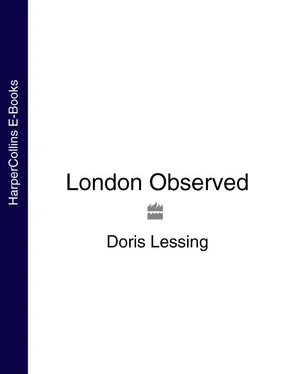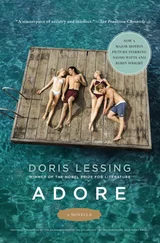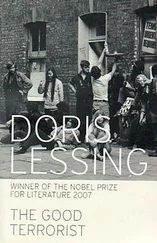Stephen, eyes still shut, went on replaying what he had seen in that room: the tenderness on Mrs Khan’s face for her afflicted child, the smile on the boy’s face, the real, warm, affectionate smile, at his sister. The little girl was swaddled in their tenderness, the family adored her, what was she going to learn at the special school better than she was getting from her family?
Stephen found he was filling with emotions that threatened to lift him off the walkway with the wind and float him off into the sky like a balloon. He wanted to laugh, or clap his hands, or sing with exhilaration. That woman, that mother , would not admit her little girl was simple. She just wouldn’t agree to it! Why, it was a wonderful thing, a miracle! Good for you, Mrs Khan, said Stephen Bentley opening his eyes, looking at the curtained windows four floors above him where he had no doubt Mrs Khan was watching him, proud she had won yet another victory against those busybodies who would class her Shireen as stupid.
‘Bloody marvellous,’ shouted the social worker into the wind. He opened his file against his knee then and there and wrote, ‘Father did not turn up as arranged. His presence essential.’ The date. His own name.
An elderly man stood with his face to the wire of the bird enclosure. Everything about him was yellowish and dry, like a fungus on an old log, but even his back was full of the vitality of indignation. In the enclosure live flamingos and demoiselle cranes, but he was looking at a fowl, a chicken, a rooster like a sunset in the act of exploding, all iridescent black, gold and scarlet, a resplendent cock who sat on a shiny log raising its wings and crowing, a triumphal shout. ‘You shut up,’ threatened the man through the wire. The cock riposted, ‘Cock-a-doodle-doo,’ or, perhaps, ‘Cock-a-rico,’ and the man said, ‘What are you so pleased with yourself about?’ – at which, ‘Crack-acrack-ooow,’ said the cock, lifting himself a few inches into the air and settling again. ‘Cock-a-rooi!’ ‘Just you shut up,’ said the man. People were looking humorous and pointing him out. He realized this, and turned, squaring his shoulders and glaring. Then off he marched, one-two, one-two, through the trees. The cock shook scarlet wattles and stepped daintily off his log.
Not far away is the paddock where the deer and the goats are kept. At that wire generations of children have learned their parents’ attitudes to the animals. ‘Nasty vicious things, goats,’ says mummy, out of centuries-old memories of goat as Lucifer, goat as witches’ friend, goat driven away under its load of sins, and a little boy says, ‘Nasty goats.’ Or, ‘Darling, look at that lovely little kid.’ But everybody loves the deer.
Deer and goats coexist. The goats are dominant. If goodies are being offered, carrots, apples, bread, then even the big stags will allow themselves to be shouldered aside by goats a third their size. If the goats are replete the stags command the fences. Then come the females, in order of their size and weight and, perhaps, even of their personalities. Behind the deer stand last year’s fawns, while this year’s, who still have their bambi foreheads (Ohhhh, look at the bambis!), stand about at the back watching their elders crowd forward to get titbits. But what the babies like best is to jump into the air on some impulse and then prance madly across the field.
The deer herd disposes itself according to rules we may only guess at. Sometimes the two stags lie among their subjects, regal creatures, holding about them atmospheres from when kings and courts hunted them, and from before that, when shamans were deer, became them in ceremonies going back thousands of years, horns bound to their foreheads. And when did foreheads sprouting horns become ribald?
Sometimes the two stags repose by themselves, or browse side by side, seeming disdainful or indifferent, while the does and fawns lie about or feed together. Sometimes, when the fawns are new, mothers and babies make a nursery place under the enormous oak, while the females too young to breed and the last season’s babies are near, but separate. Last year seven fawns were born, and the year before, seven. These surges of population cannot be accommodated, and one may arrive at the fence among all the little boys and girls who have been given carrot sticks or who have tugged up bits of grass, to find that in the night Fate has struck in the shape of a van, and borne off half a dozen or more of the herd. Where have they gone? Anguishing thoughts, better not pursued. Special friends – vanished. The white doe whose this year’s fawn learned trust for humans from her has gone, though the fawn is still here. And the infant stag, whose buds were just showing? And five of last year’s children? But the opposite also happens. The autumn before last, overnight, instead of seven fawns suddenly there were twelve, for clearly this benign place is regarded by Them, by the Fates, as a satisfactory nursery. Somewhere, in another paddock or forest or zoo, bereft does are looking for their fawns, who are prancing about here.
There are always two stags. Why two? Some lore of deer breeding must order two males for a herd. They are not friends at rutting time. As I write the second stag is sad, is desolate, stands with his head lowered, all by himself, refuses our offerings, and people can be heard, ‘Oh, poor Rudolph, are you sick?’ No, he is not sick. The Master Buck is standing on a little eminence, turning his great antlers about, tossing them, raking the grass with them, emitting grunting roars, and a reek of musk. Second Buck is being hustled away every time he approaches a female, he is being taught every minute of this long October that he is inferior. Sometimes animals emanate depression as humans do.
Soon, those now eroded and splintering antlers will fall off. The two stags will be hornless among their females, to be distinguished from them by their neck and shoulder muscles. And then … then … oh, miracles, the new horns appear, pulsing and velvety buds, and soon become like bars or handles, soft as moss to the touch, and branch, and rush up out of those tender heads and in no time there they are, the new antlers.
Astonishing events may be observed, to be interpreted anthropomorphically or not, according to taste. The summer before last, in July, it happened that we arrived at the fence as a female was giving birth. The bloody bundle dropped from the rear end of a pretty young doe, and she was turning to smell it just as her last year’s fawn, now a half-sized beast, came running. It was demented with jealousy. It knocked over the baby struggling to its feet, and began pursuing the mother around the great paddock. The poor beast, exhausted by the birth, the afterbirth protruding, was harried and hurried all around the field, sometimes staggering and letting out cries of distress. The fawn who had lost its place with her because of this birth would not let her rest nor come near the new fawn. The afterbirth tumbled. At once the crows swooped in to clean up. Meanwhile the two stags who had apparently taken no notice of all this where they lay under the oak got to their feet. First Master Buck, then Second Buck, followed by half a dozen females, walked at their leisure to the fawn lying abandoned in the grass. The two big males stood over the baby. They turned their heads to observe the mother who was still being harried by the jealous pricket. Then Master Buck bent his great head and nosed the baby to its feet. It staggered. It fell. Master Buck again put his nose under the fawn and held it up. It stood, and for longer this time. Then it collapsed. But the males and the females were satisfied. They strolled off to the fence and stood accepting bits of this and that from human friends. When we left half an hour later the mother was still trying to evade her last year’s fawn, hoarsely protesting, and sometimes falling.
Читать дальше











